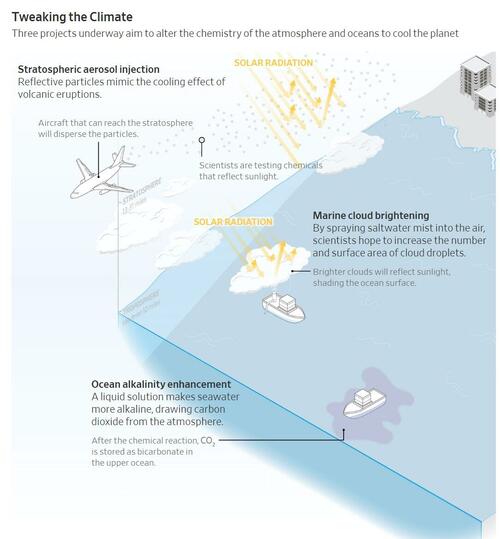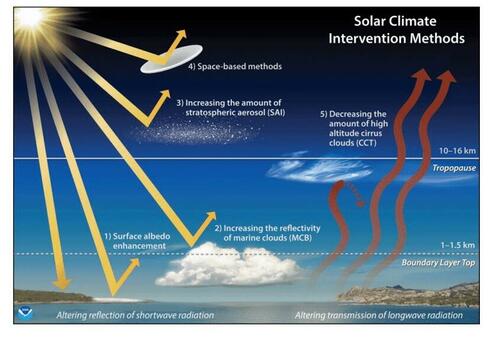Authored by Mike Shedlock via MishTalk.com,
Scientists desperate to stop or reverse climate change are dumping chemicals in the ocean and spraying saltwater in the air. What can go wrong? I discuss the short and long term.
The Wall Street Journal reports Scientists Resort to Once-Unthinkable Solutions to Cool the Planet
Dumping chemicals in the ocean? Spraying saltwater into clouds? Injecting reflective particles into the sky? Scientists are resorting to once unthinkable techniques to cool the planet because global efforts to check greenhouse gas emissions are failing.
These geoengineering approaches were once considered taboo by scientists and regulators who feared that tinkering with the environment could have unintended consequences, but now researchers are receiving taxpayer funds and private investments to get out of the lab and test these methods outdoors.
Tweaking the Climate
Experiments Underway
-
Marine Cloud Brightening: Researchers aboard a ship off the northeastern coast of Australia near the Whitsunday Islands are spraying a briny mixture through high-pressure nozzles into the air in an attempt to brighten low-altitude clouds that form over the ocean. Scientists hope bigger, brighter clouds will reflect sunlight away from the Earth, shade the ocean surface and cool the waters around the Great Barrier Reef, where warming ocean temperatures have contributed to massive coral die-offs. The research project, known as marine cloud brightening, is led by Southern Cross University as part of the $64.55 million, or 100 million Australian dollars, Reef Restoration and Adaptation Program.
-
Stardust Solutions: In Israel, a startup called Stardust Solutions has begun testing a system to disperse a cloud of tiny reflective particles about 60,000 feet in altitude, reflecting sunlight away from Earth to cool the atmosphere in a concept known as solar radiation management, or SRM.
-
Dumping Lye in the Ocean: In Massachusetts, researchers at the Woods Hole Oceanographic Institution plan to pour 6,000 gallons of a liquid solution of sodium hydroxide, a component of lye, into the ocean 10 miles south of Martha’s Vineyard this summer. They hope the chemical base will act like a big tablet of Tums, lowering the acidity of a patch of surface water and absorbing 20 metric tons of carbon dioxide from the atmosphere, storing it safely in the ocean.
This reminds me of a half-baked idea in the 1960s we discussed in grade school.
The idea back then was to spray charcoal on the artic ice to stop global cooling.
In Need of Volcanos?
Experiments aimed at cooling the atmosphere by reflecting sunlight away from Earth are an attempt to mimic what happens when a volcano erupts. In 1991, Mount Pinatubo, an active volcano in the Philippines, spewed sulfur and ash into the upper atmosphere, lowering the Earth’s temperature by .5 degrees Celsius (. 9 degrees Fahrenheit) for an entire year.
But until a few years ago, many scientists opposed human interventions, fearing a slippery slope that would allow society to avoid making tough decisions about reducing emissions and could ultimately backfire.
Solar Climate Intervention
Solar climate intervention diagram from White House document linked to below.
Yeah, let’s toss ash into the air. What can possibly go wrong? Lye in the ocean? Hey, why not?
If we get too much ash in the air and lye in the ocean, we can take it out, right?
White House Guidelines
Not to worry, President Biden has Guidelines on Solar Radiation Modification.
This Research Plan was prepared in response to a requirement in the joint explanatory statement accompanying Division B of the Consolidated Appropriations Act, 2022, directing the Office of Science and Technology Policy (OSTP), with support from the National Oceanic and Atmospheric Administration (NOAA), to provide a research plan for “solar and other rapid climate interventions.”
Not only do we need brighter clouds, we need more ash in the sky to darken it.
I am sure that if we can spend trillions of dollars to brighten clouds by spraying saltwater into the air while simultaneously darkening the sky, that everything will be great.
More seriously, does anyone really think these idea can possibly scale globally? At what cost?
Short and Long Term Risks
Ironically, the short term risk is that one of these plans is actually successful.
And bear in mind data will be manipulated to show success if for no other reason than to get more funding. Then we will ramp up spending to the tune of tens of trillions of dollars, messing with mother nature, only to encounter the long term risk.
The long term risk is we do something really stupid like dumping charcoal on the Arctic as proposed in the 1960s to melt the ice in the arctic.
In other climate-related news ….
Why Are Solar Panels 44 Percent Cheaper in China than the US?
Please consider the question Why Are Solar Panels 44 Percent Cheaper in China than the US?
The True Costs of Net Zero Are Becoming Impossible to Hide
On February 6, I noted The True Costs of Net Zero Are Becoming Impossible to Hide
Bloomberg reports a 48% Surge in Costs Wrecks Biden’s Much-Lauded Wind-Power Plans.
Even with massive subsidies, these projects are not economical.
Biden’s Biggest Tool
White House spokesperson Michael Kikukawa said Biden has “used every available tool to advance the growing American offshore wind industry.”
Indeed!
His biggest tool is a pack of lies starting with a claim that these projects are cheaper and will pay for themselves.
Loading…






